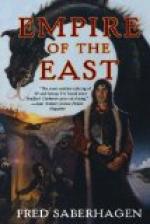The women (who were for the most part Montenegrin) showed up well in comparison with their sisters from Sarajevo, whose attire is, to say the least, comical. For in the larger towns of the Austrian occupation territory they are undergoing the stage from East to West, and appear in huge Turkish trousers and cheap, gaudy European blouses. The contrast between the Sarajevan and the graceful Montenegrin is positively ludicrous. But of all the costumes, male and female, the palm must be given to the Montenegrin. They carry themselves with a princely air, and their picturesque costume is a model of good taste; for Montenegro is, as Mr. Gladstone has remarked, the beach on which was thrown up the remnants of Balkan freedom. After the battle of Kossovo, all the Serb nobility who would not submit to the Turk fled to Crnagora, and the traces of heredity are easily to be recognised in their superb carriage.
[Illustration: MONTENEGRIN WOMEN]
It was well after midday when we reached the plateau on which the lower and modern monastery is situated. We entered through a gate into a wide path bordered with booths in which crowds of joyful pilgrims sat refreshing themselves. In spite of the departing crowds that we had passed, the place was still densely packed, for over twenty thousand people visit Ostrog. We squeezed into one of the booths and sat watching the surging mass pass to and fro.
The mixture of costume was even more marked than on the path below. It was a brilliant kaleidoscope of colour. Nothing but colour—colour. Very rarely could a man in European clothes (the richer Dalmatians) be noticed, and he seemed strangely out of place and harmony.
As we sat and gazed, two Bosnian minstrels, from bad memory and an indifferent ear, began playing on a fiddle and a guitar, and though their music was atrocious, the wild Turkish songs which they sang gave the finishing touch to the scene. It was not till they began playing snatches of music-hall airs, such long-forgotten tunes as “Daisy,” that we hurriedly moved on.
The Archbishop, Mitrofanban, heard of our arrival soon after, and immediately sent for us. When we approached, he was sitting on the steps of a house, surrounded by a brilliant staff of Montenegrin nobles and many priests, while below a great crowd of pilgrims stood in a ring, watching the national dance, which was being performed before His Grace. The dance stopped as we drew near. The Archbishop received us very kindly—this was our first meeting with him—and expressed his pleasure to see strangers from such a distant land in Ostrog. He assigned a room to us in his house, and gave orders for us to be fed during our stay. Murmuring our thanks, we attempted to withdraw, but we did not escape before we had solemnly drunk the usual coffee. It was rather an ordeal to consume that very hot coffee in the face of the multitude, and we were painfully conscious of our many shortcomings in personal appearance.




